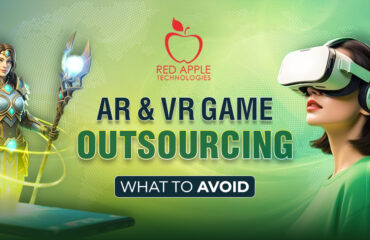
The world of education is undergoing a digital revolution, and at the forefront of this transformation are Augmented Reality (AR) and Virtual Reality (VR) technologies. These immersive technologies are not only redefining the way students learn but also making the learning process more engaging, interactive, and effective.
How AR and VR Enhance Educational Gaming
Immersive Learning Environments: AR and VR create immersive learning environments that transport students to virtual worlds, historical sites, or even microscopic levels. This firsthand experience fosters a deeper understanding of complex concepts.
Interactive Experiences: AR and VR enable interactive experiences where students can manipulate objects, conduct experiments, and solve problems in a simulated environment. This hands-on approach boosts engagement and retention.
Personalized Learning: These technologies can tailor learning experiences to individual student needs and preferences, ensuring that each learner receives the optimal level of challenge and support.
Enhanced Collaboration: AR and VR facilitate collaborative learning by allowing students to work together in shared virtual spaces, regardless of their physical location.
Gamification of Learning: AR and VR can gamify the learning process, making it more fun and motivating. This can be achieved through challenges, rewards, and leaderboards. But when adding gamification in e-learning, you should seek customized AR and VR app development services.
Real-World Applications of AR and VR in Education
History and Geography: Students can visit historical sites, explore ancient civilizations, and travel to different parts of the world without leaving the classroom.
Science and Math: Complex scientific concepts can be visualized through interactive simulations, and mathematical equations can be brought to life with 3D models.
Language Learning: Immersive language learning experiences can be created where students practice speaking and listening in virtual environments.
Medical Education: Medical students can practice surgeries in virtual operating rooms, reducing the risks associated with real-world training.
Engineering and Design: Engineers and designers can collaborate on projects in virtual spaces, sharing 3D models and blueprints with the guidance of a professional AR & VR app development company.
The Future of AR and VR in Education
As Augmented Reality (AR) and Virtual Reality (VR) technologies evolve, they are becoming more than just buzzwords—they are paving the way for a new era in education. With their ability to provide immersive, interactive, and highly engaging learning environments, these technologies are poised to fundamentally change how students engage with course material, grasp complex concepts, and develop critical skills.
Imagine students exploring ancient civilizations in 3D, conducting science experiments in virtual labs, or walking through historical events—AR and VR bring textbook material to life, offering deeper understanding and emotional connections to the subjects. In addition, they foster creativity and problem-solving, encouraging students to think critically and experiment in ways that traditional teaching methods cannot match. These immersive experiences help students retain information better, as they can learn by doing rather than just reading or listening.
For educators, AR and VR are game changers. They provide tools to tailor lessons to individual learning styles and needs, offering personalized experiences that adapt to the learner’s pace and interests. For instance, students struggling with a particular subject can access supplemental interactive resources, while those excelling can be challenged with more advanced material. Furthermore, AR and VR offer teachers a way to bring collaborative, hands-on learning into the classroom without logistical or budgetary constraints, especially in fields like medicine, engineering, and the arts.
One of the most promising aspects of AR and VR is their ability to offer learning experiences that are often otherwise inaccessible.
For example, students in remote areas or those with physical disabilities can take virtual field trips, participate in lab experiments, or collaborate on projects with peers across the globe—creating a more inclusive and equitable educational experience.
Partner with Red Apple Technologies
As AR and VR technologies continue to transform education, Red Apple Technologies stands at the forefront of this revolution. We are a leading AR & VR game development company specializing in creating innovative AR and VR experiences that engage and inspire. With our expertise, we can help you develop cutting-edge educational games and applications designed to captivate students and improve learning outcomes.
Whether you are looking to create immersive simulations for STEM education, interactive history lessons, or virtual classrooms that allow for global collaboration, Red Apple Technologies has the skills and experience to bring your ideas to life. Our custom solutions are designed to be both fun and educational, allowing students to actively participate in their learning journeys.
By partnering with us, you gain access to a team of skilled developers, designers, and educators who are committed to making learning more interactive, engaging, and impactful. Let us help you create the future of education with AR and VR—one game at a time.
Why Should You Choose Red Apple Technologies?
Innovative Design: Our team is dedicated to creating unique and immersive educational experiences that are both fun and effective.
Customization: Our AR and VR game development company works closely with educators to tailor solutions that meet the specific needs of your curriculum and students.
Expertise in AR/VR: With years of experience in developing AR and VR technologies, we know what works in educational settings and how to integrate cutting-edge solutions seamlessly.
Scalability: Whether you’re developing content for a classroom of 20 or a global network of learners, our AR and VR app development services are scalable to meet your needs.
Proven Impact: Our AR and VR educational experiences have resulted in better learning outcomes. This is evident with the success of our AR educational platform Seesaw. The learning platform is designed for kids comprising 3D models, animals, and virtual trips to provide a delightful educational experience.
To Have A Better Understanding On This Let us Answer The Following Questions
What are the key benefits of using AR and VR in educational games?
Answer: Deploying immersive technologies like Augmented Reality and Virtual Reality in educational games allows students to understand complex topics easily. It also ensures better retention with a personalized experience of learning. But to add AR and VR to educational games, you need to hire app developers from a leading tech organization like Red Apple Technologies.
What is the cost of developing an AR or VR educational game?
Answer: It entirely depends on your project objectives, features and functionalities, technology stack integration, and much more. Hence, to get the right budget estimation, you need to get in touch with a recognized AR and VR app development company.
What are the top platforms for AR and VR educational game development?
Answer: There are cutting-edge development platforms like Unreal, Unity, ARKit, Vuforia, and others that are useful in developing immersive AR/VR educational games of different types. For assistance, you can get in touch with a leading AR and VR app development agency.






























 Book an Appointment
Book an Appointment Get Instant Project Estimation
Get Instant Project Estimation WhatsApp Now
WhatsApp Now






 Book An Appointment
Book An Appointment WhatsApp
WhatsApp







